Toyota bZ4X Joins the EV SUV Party Just in Time
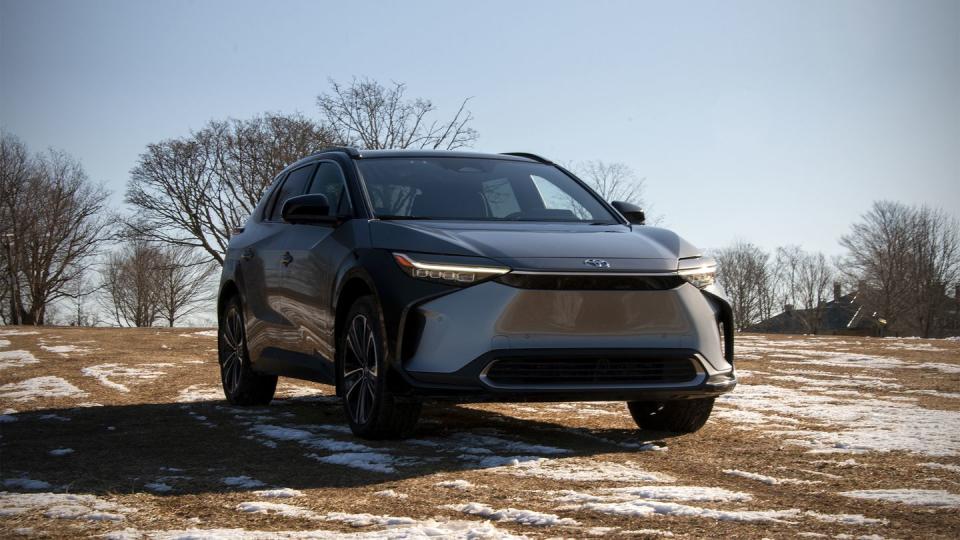
Toyota has been viewed as something of an EV holdout, despite a few small-scale experiments over the years, and still continues to be seen as taking a wait-and-see approach to battery-electric models.
The automaker may have surprised the EV-anxious public with a slate of wild concepts not too long ago, but its first mass-market EV has set its sights on repeat RAV4 buyers.
The bZ4X has already had something of a hiccup during its early market debut stateside, with a recall that paused sales. The situation has been cleared up, and Toyota now has a genuine competitor in a segment that is bound to be among the busiest for EVs this decade.
This also means it has to find a way to stand out in a sea of similarly sized electric models, each vying for attention and each arriving with its own set of complex explanations regarding the EV tax credit, and just for what EV networks it will offer the sweetest deal.
Both of these factors make EV shopping something of a chore at the moment, especially since the EV tax credit was reworked by the government in a confusing manner and prompted frazzled automakers to correct and explain things to car shoppers.
It also remains a post-sale rebate, not a point-of-sale coupon you can just present at the dealership when picking up your car. But that's just how things are at the moment.
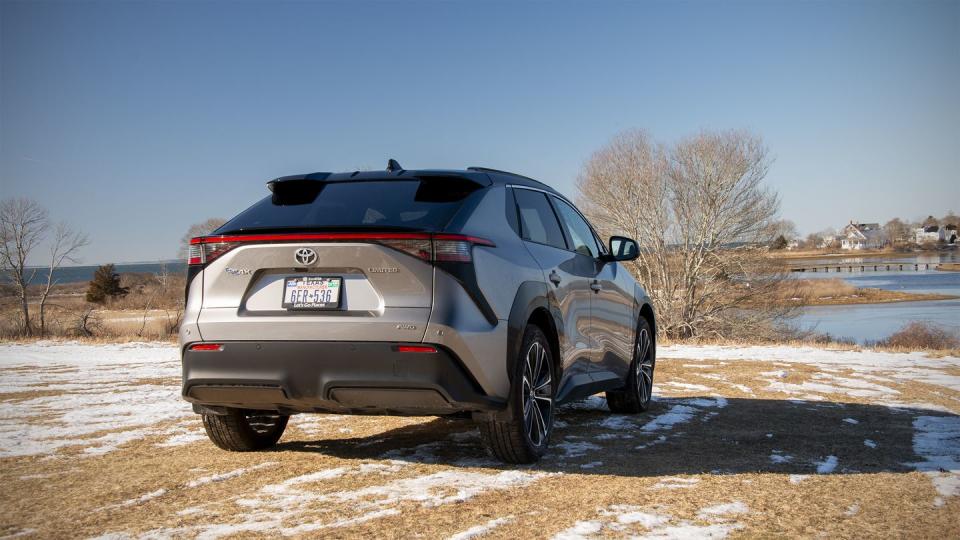
Despite all of these sub-optimal (and slightly nauseating) car shopping realities, the bZ4X is the first mass-market EV that repeat Toyota buyers will really have the option of taking home (while repeat Honda shoppers now have the Prologue and Nissan families have the Ariya to try). This means it has to make a good impression early on, opening the door to all of those cool electric concepts that Toyota showed off a couple of years ago.
Did our week in the 2023 bZ4X prove that it's a capable (electric) family truckster, even for those who have been on the fence about the whole EV thing?
The bZ4X greets us with an interior that is a sea of black plastic, albeit with some avant-garde design solutions, like an instrument cluster placed far ahead of the steering wheel, just below the windshield, designed to be viewed without averting one's gaze from traffic too far.
The instrument cluster is protected from glare by two walls on each side, lending it an arcade game look that works well with the design of the dash itself, even if the color palette is mostly monotone.
But being positioned so far forward, the driver either needs to look through the steering wheel or above it to view it unobstructed. This is a minor quibble.
The central infotainment screen, meanwhile, flows from a high-set center console that also houses a bin for inductive phone charging, while underneath the "bridge" there is more storage space for other items.
The dash would have remained a sea of black plastic were it not for the passenger side of the dash featuring a fabric surface—a curious item that we hope will not become easily scuffed with time.
The seats are ergonomic and supportive, even if some of the plastics inside are perhaps a little too frugal. But this isn't a Lexus, after all, so there is room for more generous materials further up in the automaker's range. The Subaru Solterra is based heavily on the bZ4X and is another version to consider.
The 12.3-inch infotainment screen still retains plenty of separate (but solid-state) buttons underneath—buttons susceptible to fingerprints, since we're still in the Piano Black era of interior design. But the screen's position and legibility are equally adequate. Thankfully, most of the functions you'll need regularly aren't buried in sub-menus, which is no small blessing in this day and age.
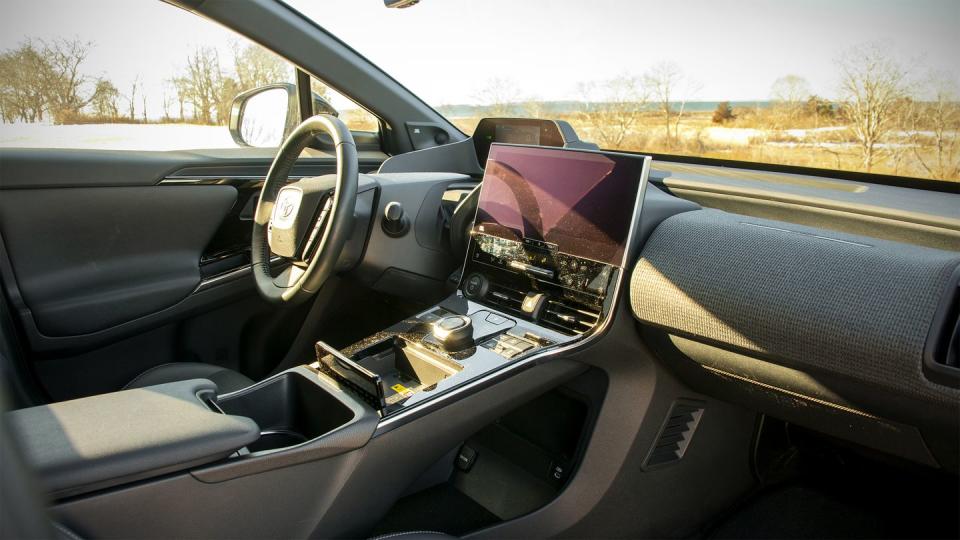
Toyota's drive mode controller is simple to use, as far as these things go, quickly snapping back to center after each selection, with a separate Park button positioned just north of it.
When it comes to handling, the bZ4X errs on the side of comfort, with our Limited trim AWD model providing good acceleration with its two motors producing a collective 214 hp.
Mashing the accelerator will produce reasonably brisk take-off, and it's more than enough for safe highway entries. So it's not lacking in power. Regenerative braking feels consistent for the most part. It doesn't have one-pedal driving, but there is a button for activating Regenerative Braking Boost. It may take some getting used to under hard deceleration.
Likewise, the suspension is tuned for everyday comfort, soaking up broken pavement reasonably well while also keeping body roll mostly in check in the corners. The steering feel is on the soft side, however, and that's because this is a family car, after all, one which will be a replacement for some of those coming out of the RAV4.
With its 65.5-kWh (usable) battery, the range performance in town seems perfectly adequate, with no miles disappearing for no reason, but its highway performance was on the skimpy side in warmish and cold weather alike.
Our week in the bZ4X also coincided with an opportunity to test it on a modest local trip of sorts in cold temperatures, starting with a fully charged battery—something we rarely do with an EV unless we plan it on purpose.
We had to make a run to the airport and back, 90% of which would be highway driving, and would cover about 55 miles each way. With an EPA rating of 222 miles, this quick highway run should be... at least free of range anxiety.
We started off with a 100% state of charge at 35 degrees, with the range estimator already showing a slightly depressing 179 miles at start up. That's fine—we were expecting a kick to the shins right at the start, being cold and all and having to run the heat. A few minutes later these 179 miles became 159 miles, and proceeded to drop rapidly as we cruised on the interstate to the airport.
Having traveled 55 miles, exactly halfway, we had just over 100 miles remaining, according to the instrument panel, which, you might note, is not usually how math works in the real world, but instead is how math works in the EV world when it's near freezing outside.
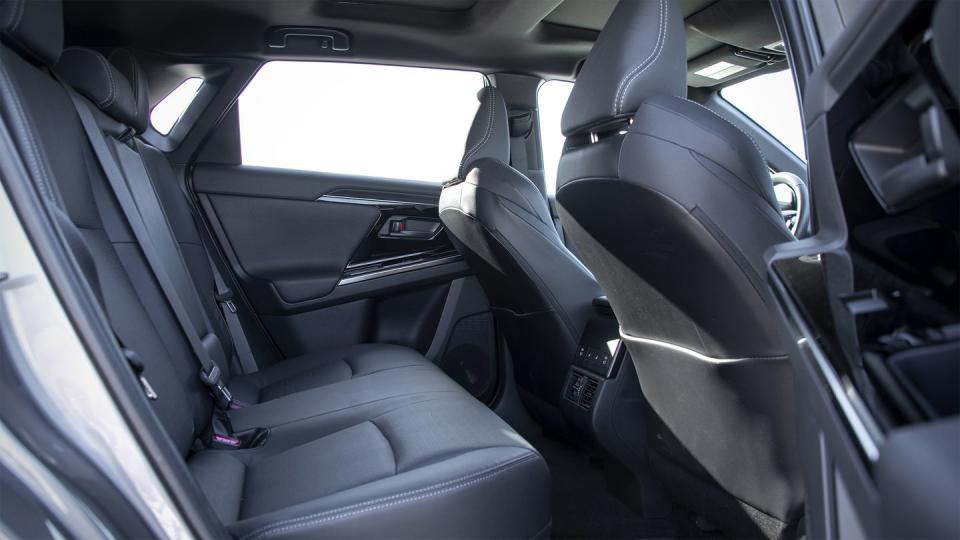
We made it back home having traveled 110 miles with a 34% state of charge remaining. So that distance ate up 66% of the battery charge, having traveled at highway speeds most of the way with temperatures of 35 degrees outside (or actually quite a bit lower to adjust for wind chill at highway speeds).
Of course, these are highway speeds in cold weather, but yet another shorter trip with temperatures around 50 degrees produced a similar rate of energy consumption on the highway.
So for an EV theoretically rated by the EPA at 222 miles, you will definitely have something well south of 200 miles on tap if you plan a highway trip lasting a couple of hours.
Of course, the bZ4X is unlikely to be the only car in the buyers' households—an observation rarely voiced by automakers aloud.
This will likely be that second or third or fourth car in the household for most buyers, even if TV commercials won't yell out this fact at you, along with how much money you probably make if you're shopping for an EV in this general price range.
When it comes to cargo space, the rakish hatch—certainly in vogue at the moment—does not eat up as much space as one would think, and with the back seats folded down we could haul quite a bit of luggage on a couple of trips.
But still, it's stingier on space than the RAV4, offering about 10 fewer cubic feet with the seats up, and about 13 cubic feet fewer with the seats down.
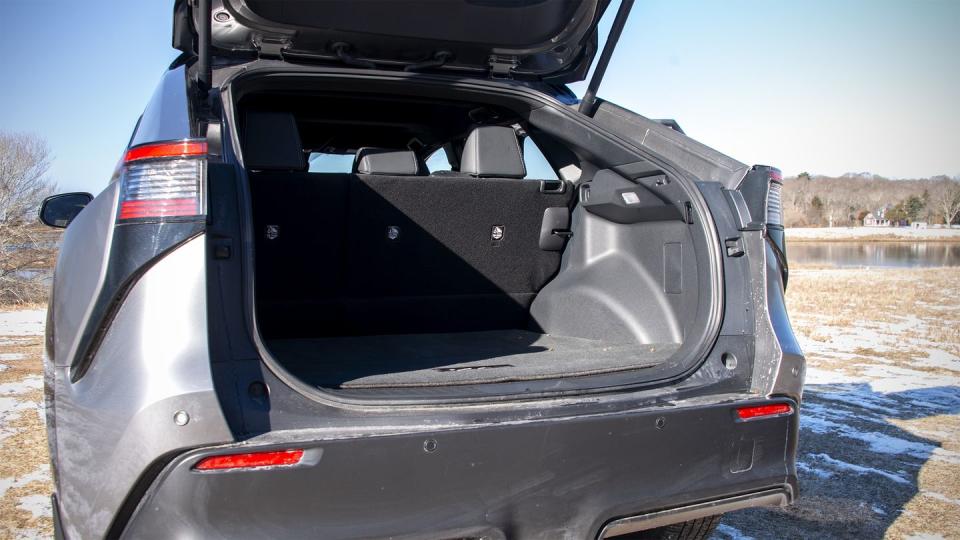
But there is no frunk even for a small bag or something similarly sized, so don't count on popping the hood anytime soon when you have to run a bunch of errands around town and start running out of space.
Likewise, this is not the kind of vehicle that would accommodate a third row—it's a size below it. So don't look for that option on the menu screen.
Overall, the bZ4X is a logical first mass-market EV for Toyota, but one that comes with some compromises.
The Limited AWD version we drove was priced $52,468 out the door, which is not bad for something with these features in this day and age, because this is pretty much the top model, albeit one with the least range in the bZ4X lineup—it tops out at 252 EPA miles in XLE FWD flavor.
But longer-range EVs are certainly out there today, and we feel that its official 222-mile estimate may seem outdated in a few years, if it doesn't already.
The Limited AWD trim, meanwhile, will make sense to those who want a few more luxuries inside like heated steering wheel, heated seats, and the Softex faux-leather upholstery, and might not need as much range. The $2080 price bump for AWD, meanwhile, makes this upgrade inexpensive if you live in a part of the country where AWD comes in handy.
As such, the XLE trim front-wheel-drive bZ4X with almost as much power and battery—but greater range—is perhaps a more logical purchase at the moment if you just need a daily runabout with not a lot of frills. Because you'll be getting a lot of the same experience at a bit of a discount.
Will electric SUVs of this size need to offer at least 300 miles of range to replace everyday commuters, or is 200 miles adequate, allowing there is another car in the household for other use cases? Let us know in the comments below.

 Yahoo Autos
Yahoo Autos 